
QA (Quality Assurance) automation can be a significant investment for a business. But just like any investment, the goal is to get a favorable return. So, how can you calculate the return on investment for QA automation?
Cost of QA Automation
Before you can calculate the return on investment for QA automation, it’s crucial to understand the associated costs. The key costs to consider include:
- Automation tool costs: Many automation tools require a subscription or a license to be used.
- Implementation costs: These include the costs of time and resources to set up and run automated tests.
Training costs: Automation requires specific skills. You may need to invest in training for your team. - Maintenance costs: Ensuring that automated tests remain relevant and effective as your products or services change, can require ongoing effort and cost.
According to a study from the IBM System Journal, test automation can account for up to 30% of the total cost of software development.
Benefits of QA Automation
While QA automation does have its costs, it also brings a number of benefits that can increase profitability:
- Reduced Test Duration: A study from Capgemini revealed that automation can reduce test times by 50-75%.
- Increased Test Coverage: Automation can increase test coverage by 80-90%, according to research from Vanson Bourne.
- Improved Product Quality: With the ability to test more thoroughly and more frequently, QA automation can improve product quality, which can lead to greater customer satisfaction and, therefore, higher revenues.
- Long-term cost reduction: While the initial investment can be high, operational costs can decrease over time due to reduced errors and improved efficiency.
Calculating the ROI of QA Automation
The basic formula for calculating ROI (Return on Investment) is:
ROI = (Net Profit / Total Cost) x 100%
In this case, the net profit can be calculated as the cost of manual testing minus the cost of automated testing. These costs should include both initial costs and maintenance costs.
For example, if you spend 10,000€ per year on manual testing and automation testing costs 6,000€ per year (including initial and maintenance costs), then the net profit would be 4,000€. Using the formula above, the ROI would be 66.7%.
It’s important to remember that the ROI can change over time. According to a study from the University of Cambridge, the benefits of QA automation typically start to manifest after about a year of implementation.
Examples of ROI in QA Automation
Here are some examples of ROI in QA automation based on industry case studies:
- Cisco Systems: They implemented automated testing for their software development processes and found that, although initial costs were high, they achieved a positive ROI after 3 years. The ROI increased to 200% after 5 years due to savings in time and effort.
- Microsoft: They discovered that automating the testing of their software development processes allowed them to increase their efficiency by 15-20%. This translated into a significant ROI in terms of time savings and improved product quality.
- SAP: They implemented automated testing for their software development process and achieved an ROI of 25% after just 1 year. The savings came from reduced test time and improved product quality.
Calculating the return on investment for QA automation requires taking into account both costs and benefits, and considering how these can change over time. Be sure to regularly review your costs and benefits to get an accurate picture of your ROI and adapt your QA automation approach as necessary.
One way to reduce the cost of QA automation is by outsourcing QA engineers from Qualitapps. This option allows companies to benefit from the expertise and skills of a dedicated QA team, without the costs of hiring and training an internal team. Qualitapps’ experience can help optimize QA automation, thereby maximizing ROI.





